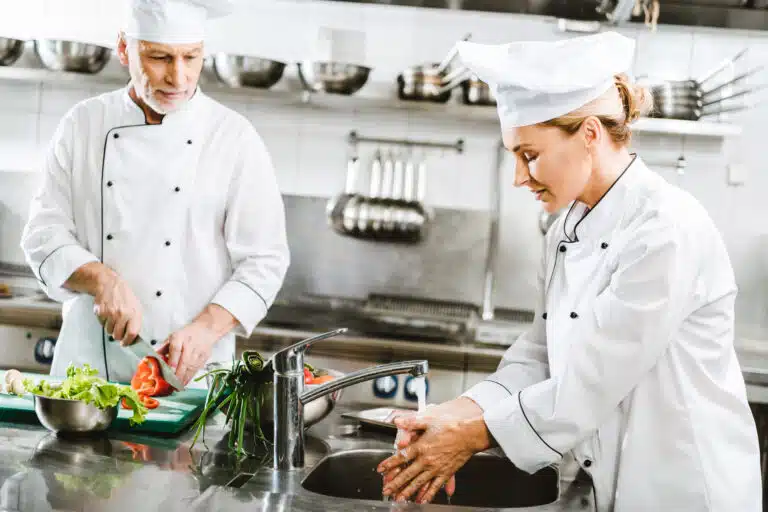Table of Contents
- Introduction
- What Are Physical Hazards in Food Safety?
- Common Types of Physical Hazards
- How to Prevent Physical Hazards
- UK Legal Requirements for Physical Hazard Control
- How Skilltopia’s Courses Ensure Compliance
- Frequently Asked Questions
- Get Started with Skilltopia
Introduction
Physical hazards in food safety can compromise the safety and quality of food, posing risks to consumers and damaging the reputation of UK food businesses. From restaurants and cafés to food vans and manufacturers, managing these hazards is essential to comply with the Food Safety Act 1990 and achieve high FSA hygiene ratings. Physical hazards, such as glass, metal, or plastic, can contaminate food at any stage of production or service, making robust prevention measures critical. Skilltopia’s CPD-certified online courses, including Food Hygiene Levels 1–3 and HACCP Levels 2–3, equip staff with the skills to identify and control physical hazards. This SEO-optimised guide, crafted following Google’s best practices, explores physical hazards, prevention strategies, and how Skilltopia’s training ensures compliance. Enrol at skilltopia.co.uk/buy-courses to protect your business and customers.
What Are Physical Hazards in Food Safety?
Physical hazards are foreign objects that can contaminate food, causing injury or illness to consumers. These non-biological contaminants can enter food during production, preparation, or service, often due to human error, equipment failure, or environmental factors. Unlike chemical or biological hazards, physical hazards are typically visible but can go unnoticed without proper controls. In the UK, managing physical hazards is a key focus of Environmental Health Officer (EHO) inspections and certifications like SALSA and ISO 22000. Effective management ensures compliance, enhances customer safety, and protects your business’s reputation in competitive markets like London or Birmingham.
Common Types of Physical Hazards
Physical hazards vary depending on the food business’s operations. Common types include:
- Glass: Broken glass from containers, light bulbs, or windows can contaminate food.
- Metal: Fragments from equipment, utensils, or packaging (e.g., can lids) can enter food.
- Plastic: Pieces from packaging, gloves, or equipment can contaminate food during processing.
- Wood: Splinters from pallets, crates, or wooden utensils can pose risks.
- Stones or Soil: Natural contaminants from unwashed produce, like vegetables or fruits.
- Personal Items: Hair, jewellery, or fingernails from staff handling food.
- Pests: Insects, droppings, or pest-related debris can contaminate food surfaces.
Skilltopia’s Food Hygiene Level 2 course trains staff to identify and prevent these hazards effectively.
How to Prevent Physical Hazards
Preventing physical hazards requires proactive measures integrated into your food safety management system. Follow these best practices:
- Maintain Equipment and Facilities. Regularly inspect and maintain equipment to prevent wear that could release metal or plastic fragments. Replace glass containers with shatterproof alternatives and use protective covers for lights.
- Implement a Clean As You Go Policy. Encourage staff to clean and inspect surfaces during tasks to remove potential contaminants like hair or debris. Skilltopia’s Food Hygiene Level 2 course teaches this practice.
- Use Proper Personal Hygiene. Ensure staff wear hairnets, beard nets, and minimal jewellery. Prohibit nail polish or artificial nails in food handling areas.
- Implement Pest Control. Use sealed bins, pest-proof storage, and professional pest control services to prevent contamination from insects or rodents.
- Check Supplier Ingredients. Inspect incoming produce for stones, soil, or packaging debris. Maintain supplier records for traceability, as taught in Skilltopia’s HACCP Level 2 course.
- Use Detection Systems. For manufacturers, install metal detectors or sieves to identify and remove physical contaminants during processing.
- Integrate with HACCP. Incorporate physical hazard controls into your HACCP plan, identifying critical control points (CCPs) like ingredient inspection or equipment checks. Skilltopia’s HACCP Level 2 and 3 courses guide this process.
- Conduct Regular Audits. Perform internal checks to ensure hazard controls are effective. Document findings for EHO inspections, as covered in Skilltopia’s Food Hygiene Level 3 course.
- Train Staff. Ensure all staff are trained to recognise and prevent physical hazards. Skilltopia’s CPD-certified courses provide comprehensive training for compliance.
UK Legal Requirements for Physical Hazard Control
UK food businesses must comply with regulations to manage physical hazards, including:
- Food Safety Act 1990: Requires food to be safe and free from harmful contaminants.
- Regulation (EC) No 852/2004: Mandates HACCP-based systems to control all hazards, including physical ones.
- General Food Regulations 2004: Prohibits placing unsafe food on the market, including food with physical contaminants.
Non-compliance can result in fines (up to £5,000), lower FSA ratings, or business closure. Skilltopia’s courses ensure your team meets these legal standards.
How Skilltopia’s Courses Ensure Compliance
Skilltopia’s online courses, certified by The CPD Certification Service, equip your team to manage physical hazards:
- Food Hygiene Level 1: Covers basic hygiene and contamination prevention for support staff (1-2 hours).
- Food Hygiene Level 2: Teaches food handlers to prevent physical contamination, including cleaning and inspection protocols (4-6 hours).
- Food Hygiene Level 3: Equips managers with HACCP and audit skills to control physical hazards (10-12 hours).
- HACCP Level 2 and 3: Guides staff and managers in creating systems to manage physical hazards.
Starting at £12.50, our courses are affordable, flexible, and provide instant downloadable certificates for EHO inspections. Contact hello@skilltopia.co.uk for bulk discounts or enrol at skilltopia.co.uk/buy-courses.
Frequently Asked Questions
What are physical hazards in food safety?
Physical hazards are foreign objects like glass, metal, or hair that can contaminate food, causing injury or illness.
Are physical hazard controls mandatory in the UK?
Yes, under the Food Safety Act 1990 and Regulation (EC) No 852/2004, businesses must control physical hazards.
How can Skilltopia’s courses help with physical hazards?
Our CPD-certified courses teach staff to identify, prevent, and manage physical hazards for compliance.
What happens if physical hazards are not managed?
Non-compliance can lead to fines, low FSA ratings, or consumer harm, damaging your business’s reputation.
Get Started with Skilltopia
Managing physical hazards is crucial for food safety and compliance in UK businesses. Skilltopia’s CPD-certified online courses provide the training needed to protect your customers and pass inspections. Enrol at skilltopia.co.uk/buy-courses or email hello@skilltopia.co.uk for tailored training solutions.
Skilltopia is your trusted provider of CPD-certified online food hygiene training for UK businesses. Stay safe and compliant!






